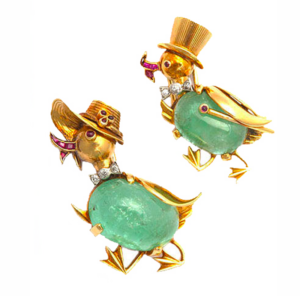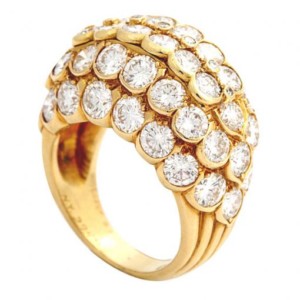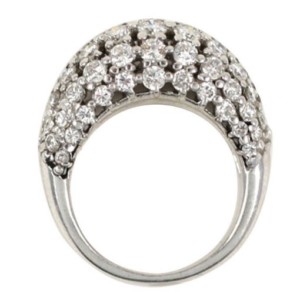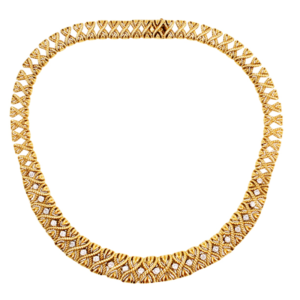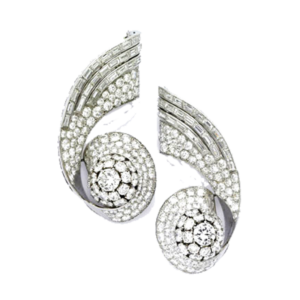The world renowned firm of Van Cleef and Arpels is famous for creating and producing some of the most elegant and cutting edge jewelry, with close attention to detail and quality. They also developed and utilized many innovative designed and techniques.
The firm of Van Cleef and Arpels had its beginnings in 1898, when Alfred Van Cleef (1873-1938) married his cousin, Estelle Arpels. Both Alfred and Estelle had a background in jewelry. Alfred was the son of Charles Van Cleef, a prominent jeweler who had become well-known in Paris for his ability to re-cut flawed gem stones, thus increasing their value. Estelle Arpels was the daughter of Léon Arpels, a dealer in precious stones.
Alfred had always been interested in designing jewelry, and began an apprenticeship in the workshops of Messrs. David and Grosgeat, where he stayed for six years. In 1906, Alfred and Estelle went into partnership with two of Estelle’s brothers, Charles (1880-1951) and Julien Arpels (1884-1964), and founded the firm Van Cleef and Arpels.
The first location of VC&A was on the upper floor of an office building at 34 rue Drouot. Their business flourished at rue Drouot, and they gained such a strong reputation that they soon moved to the Place Vendôme, an exclusive area known for the most elegant and prominent jewelers.
By 1912, the firm had grown to include a staff of over fourteen people, and had expanded to popular resort towns, such as Deauville, Biarritz, and Vichy. The expansion allowed the firm to target the elite, including royalty, who traveled regularly to these towns for vacation. Also at this time, Louis Arpels (1886-1912), the youngest Arpels brother, joined the firm.
Unfortunately, in 1914, World War I interrupted VC&A’s business. Charles and Louis were called away to war, while Alfred, who was exempt due to poor health, managed the firm on his own for four years. Estelle served as a nurse during this time, and cared for Emile Puissant, a young lieutenant who had been injured. Emile later met and married Renée Van Cleef, the daughter of Estelle and Alfred, and became responsible for the administration of the firm.
Even during the war, VC&A continued to be a successful business, as well as one of the top jewelry houses by continuing to produce creative and appealing jewelry. While they continued to design pieces with the extraordinary gemstones that they were known for, they also showed that they were able to break with convention by creating a line of jewelry made from wood. The ability to be classic, yet creatively flexible defines the style of VC&A, and contributed in large part to the firm’s continued success.
Another innovation that began during the war was started by Emile Puissant. Emile began a remarkably novel practice that, until now, had been unheard of in the jewelry world: every year, during the month of December, Van Cleef and Arpels held a sale, marking down between seven hundred and one thousand items, which were described in great detail in a catalogue. This practice irritated rival establishments, but proved to be great for business. Unfortunately, Emile’s career only lasted until 1926, when he was killed while car racing.
When Emile died, Renée took over the position of artistic director. Renée had brilliant ideas, but could not draw, so she partnered with René-Sim Lacaze, a highly gifted draftsman and designer. Both Renée and René-Sim were very creative and complimented each other’s tastes and talents. René-Sim would capture their ideas and create sketches that would be reviewed by Renée, and then sent back to René-Sim with any modifications, to ensure perfection.
The style of jewelry that Van Cleef and Arpels produced during the twenties emphasized the ideas of classicism, while also remaining relevant, original, and imaginative. The discovery of King Tutankhamen’s tomb in 1922 caused a resurgence of Egyptian themes and motifs, which were picked-up by all the important jewelry houses, but perhaps best utilized by VC&A in their extraordinary collection of bracelets and brooches depicting Egyptian themes. This discovery also influenced the use of unusual stone combinations including semi-precious stones such as cornelian, lapis lazuli, and turquoise.
In addition to Egyptian themes, Van Cleef and Arpels produced jewelry that was influenced by China and Japan. Using jade, coral, pearls, and enamel, VC&A created pieces with naturalistic decorative elements such as dragons, fishermen, and pagodas, or Chinese ideograms. The interest in Egypt and the Orient further expanded the color palette of gemstones that VC&A used to create jewelry, expanding their ability to create jewelry full of unexpected and dramatic contrasts.
The jewelry that VC&A produced during this time was also highly influenced by the modern clothing fashions of the twenties. One of the most characteristic pieces of jewelry that VC&A executed many designs for during the twenties was the sautoir. The sautoir first made its appearance during the late ‘teens – it is a very long necklace, usually of small pearls or stone beads terminating in a tassel, which was often jeweled, enameled or otherwise embellished, and often ended in another tassel of silk. The sautoir complimented the tunic dresses, which would have been belted at the hip – a very popular style during the twenties. VC&A created a multitude of variations of the sautoir, utilizing the expanded color palette of gemstones that were newly popular.
The fashion of bare arms in the twenties also brought about another one of VC&A’s most characteristic pieces of jewelry – the wide bracelet. This trend lasted through the mid thirties. These wide bracelets were flat and flexible, and often done in geometric composition, an element that reflected the influence of Art Deco. They were typically made in platinum, and set with diamonds, often in combination with colored gemstones.
The new fashion for short hair made long pendent earrings the favored style. These earrings would be accented with motifs in the form of drops, cascades, or even bunches of fruit. Again, VC&A utilized their expanded gemstone and color palette to create original designs and interesting color contrasts to bring even more drama to these already dramatic jewelry accessories.
Other popular items that VC&A created during this time were multi-use brooches, brooches in the shape of bowties, a collection of jeweled birds- a departure from the geometric forms that were so prevalent, bracelet watches, and a collection of pieces that were flower themed, which won VC&A the Grand Prix at the Exposition Internationale des Arts Décoratifs in 1925.
In 1932, Claude Arpels joined VC&A, and was the first member of the second generation to join the business. With the coming of WW2, it seemed prudent for the firm to open in New York City, and Claude is credited with opening the VC&A store in New York City in 1939, establishing VC&A as one of the first luxury jewelers to move to America. Claude’s brothers Jacques and Pierre later enter the company in 1936 and 1944. To avoid the heavy taxes on the import of manufactured jewelry, the jewelry was sent over in parts, and assembled in New York, much of it by Oscar Heyman, some by John Rubel.
The 1930’s brought about a shift in jewelry styles – white metals and strict geometry were going out of fashion, and VC&A abandoned geometric styles for more curves, with figurative and romantic motifs in highly polished yellow gold. Birds and vegetal motifs were in favor, and usually embellished with diamonds, rubies and sapphires – emeralds were difficult to get during the war. Multi-purpose jewelry had become very popular during this time – thrifty-minded women wanted their jewelry to serve several functions. Necklaces could come apart to be bracelets, or have elements that could be removed and worn as clips or earrings. Brooches could separate to become clips or earrings. Van Cleef & Arpels developed many ingenious techniques to accomplish this, including “secret hinges” and “invisible articulations.” In fact, Van Cleef & Arpels produced some of the most technically demanding jewelry of any of the famed jewelry houses.
One of the most remarkable inventions that Van Cleef and Arpels developed was the serti invisible, or invisible setting, in 1933, although other jewelry houses, among them Cartier, also claimed to have developed it. This technique required months of work by master craftsmen, as each stone had to be precisely cut so as to fit perfectly next to its neighboring stone into a gold framework which held the stones in place so that the setting was invisible. This technique allowed the jeweler to create an un-broken surface of color, and was truly revolutionary. The serti invisible was applied to many of VC&A’s most important and fabulous pieces, including many that were made for the Duchess of Windsor.
The Passe-Partout was another important stylistic development. It translated as “go anywhere”. The passe-partout, using a technique developed by VC&A, transformed flat or rounded gold wire into a flexible coil, which could be used in many ways, and other jewelry houses used it as well. It was also known as tubo-gaz, or “gas pipe”. This was very popular in jewelry created throughout the 1940’s and 1950’s, and first made its appearance in the late 1930s. It could be flat or rounded, and worked well as a simple necklace or bracelet, or could have various stylized floral elements, usually in yellow or pale blue sapphire accented with small rubies, that attached in various ways to create necklaces or become bracelets by clever coiling of the passé-partout and attachment of the decorative elements.
The “gas pipe” was also used to great advantage for VC&A’s Hawaii Collection, which featured small florets of stones – usually combinations of rubies, sapphires, turquoise and diamonds scattered across a jewel, or made into brooches, earrings and rings, compacts and pill boxes. This style, when used for bracelets, was also known as pelouse, or lawn, as it resembled a lawn strewn with flowers. It was also used for their Cous Cous pieces – necklaces and bracelets adorned with balls of gold and patterns of colored stones.
Van Cleef & Arpels developed another important technique in the 1930’s that was widely adopted by other jewelry houses – the Ludo-hexagone. This involved small, hexagon-shaped gold elements attached to each-other so as to form a flexible band. Each element was usually set with a small diamond or colored stone in a sertie etoilé, or engraved, star-shaped setting, which was also widely adopted by other jewelers.
Another remarkable technical innovation was the Zip Necklace, designed by Renée Puissant for the Duchess of Windsor in 1951. This was designed as an actual zipper, bordered with diamonds and rubies that could actually be “zipped” closed to form a bracelet.
The jewelry that VC&A designed in the 1940’s and 1950’s emphasized naturalism and romanticism. The Ballerina brooches, with the dancer’s face formed by a single old-mine diamond were a huge success. For some of them, the entire gown was composed of diamonds. Others incorporated colored stones, such as emeralds, or a combination of turquoise and ruby.
There is some dispute as to who actually originated these pieces – there is evidence that they were designed jewelry designer Maurice Duvalet for both VC&A and John Rubel. There were also gypsy brooches, cupids and fairies. They were extremely popular throughout the 1940’s.
Also very popular through the ’40’s and into the early ’50’s was the “Chantilly” style, composed of gold “lace” often set with small diamonds – this worked well at that time, as gold was scarce, and the open-work of the lace made for a substantially sized piece that used less gold. Snow-flakes, starred flowers with diamond centers, and the “Valenciennes” style of flowers that were arranged in a ribbon-lace pattern also became signature styles of VC&A.
Floral designs became very popular in the 1950’s, a trend that would last throughout the 1960’s, along with animal designs. Cute “scatter pins” were a new fashion must, and VC&A made many amusing pieces, including the bees, usually done in yellow and blue sapphires and meant to be worn in groups. A collection of bird-inspired jewelry created at the end of the 1940’s and continuing into the 1950’s was also widely popular, and featured a combination of gold and precious stones that were often carved – probably imported from India. The best example of this is the ring nicknamed “Lovebirds,” which was made in the 1950’s. The hugely successful Alhambra Collection was introduced in 1968, and has recently made an enormous come-back.
The designs created throughout the 1970’s were highly influenced by the Arpel’s trips to India, and were composed of multicolored stones and daring juxtapositions. These pieces were very stylized and were inspired by jewelry worn by the Maharajahs.
The 1970’s saw a resurgence of the sautoir necklace. This incarnation, however, was quite different from the slender and delicate pieces of the 1920’s. They were much bolder and heavier, often composed of gold links that resembled nuggets, and some very elaborate pieces with quantities of precious and semi-precious stones, with large brooches and earrings to match.
Ribbons and bows became the focus of many of VC&A’s pieces during the 1980’s, and many of the old styles were recreated using the new technology and techniques that had been discovered.
The House of Van Cleef and Arpels continues to be run by the Van Cleef and Arpels’ family and is still one of the top jewelry houses throughout the world. It continues to expand its company and has participated in numerous fairs and exhibitions, often winning prizes for its designs.
Showing all 6 results
-
$4,000,050,000.00
-
$2,000,030,000.00
-
$3,000,040,000.00
-
$50,000.00
-
$500,010,000.00


